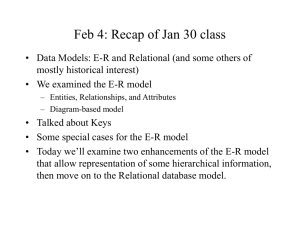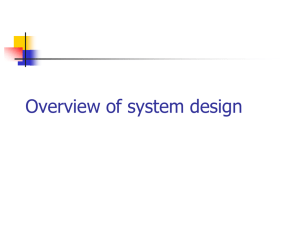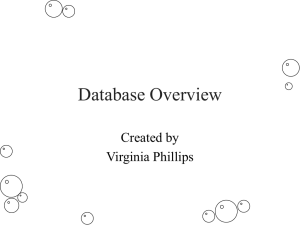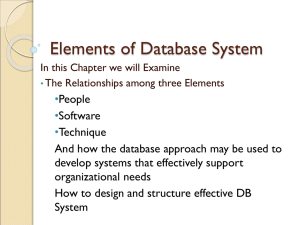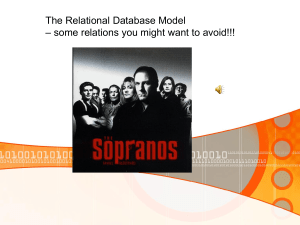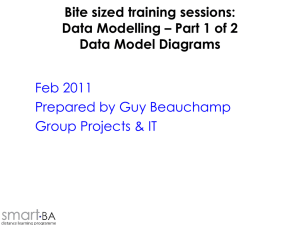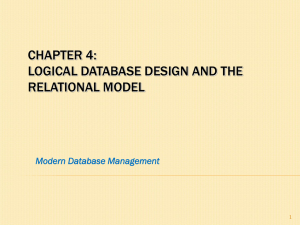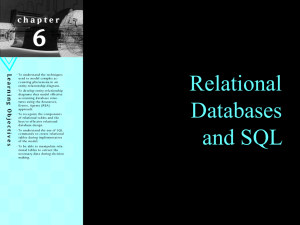Logical Database Design & Relational Model Presentation
advertisement
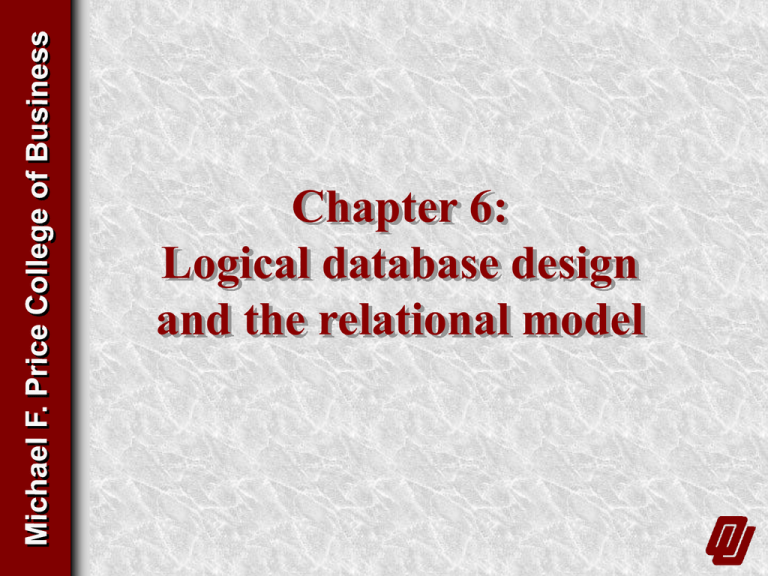
Chapter 6: Logical database design and the relational model Objectives of logical design... Translate the conceptual design into a logical database design that can be implemented on a chosen DBMS • Input: conceptual model (ERD) • Output: relational schema, normalized relations Resulting database must meet user needs for: • Data sharing • Ease of access • Flexibility Relational database components Data structure • Data organized into tables Data manipulation • Add, delete, modify, and retrieve using SQL Data integrity • Maintained using business rules Why do I need to know this? Mapping conceptual models to relational schema is straight-forward CASE tools can perform many of the steps, but.. • Often CASE cannot model complexity of data and relationship (e.G., Ternary relationships, supertype/subtypes) • There are times when legitimate alternates must be evaluated • You must be able to perform a quality check on CASE tool results Some rules... Every table has a unique name. Attributes Every in tables have unique names. attribute value is atomic. • Multi-valued and composite attributes? Every row is unique. The order of the columns is irrelevant. The order of the rows is irrelevant. The key... Relational modeling uses primary keys and foreign keys to maintain relationships Primary keys are typically the unique identifier noted on the conceptual model Foreign keys are the primary key of another entity to which an entity has a relationship Composite keys are primary keys that are made of more than one attribute • Weak entities • Associative entities Implementing it Attribute Instance Field Entity What about relationships? Constraints Domain constraints • Allowable values for an attribute as defined in the domain Entity integrity constraints • No primary key attribute may be null Operational constraints • Business rules Referential integrity constraints Referential integrity constraint Maintains consistency among rows of two entities • matching of primary and foreign keys Enforcement • Restrict • Cascade • Set-to-Null options for deleting instances Transforming the EER diagram into relations The steps: Map regular entities Map weak entities Map binary relationships Map associative entities Map unary relationships Map ternary relationships Map supertype/subtype relationships Transforming E-R diagrams into relations Mapping regular entities to relations • Composite attributes: use only their simple, component attributes • Multi-valued attributes: become a separate relation with a foreign key taken from the superior entity Mapping a composite attribute Looks like this using relational schema notation Transforming E-R diagrams into relations Mapping weak entities • Becomes a separate relation with a foreign key taken from the superior entity Example of mapping a weak entity Looks like this using relational schema notation Transforming E-R diagrams into relations Mapping binary relationships • One-to-many - primary key on the one side becomes a foreign key on the many side • Many-to-many - create a new relation (associative entity) with the primary keys of the two entities as its primary key – I like to call these intersection entities to distinguish them from associative entities created at the conceptual level • One-to-one - primary key on the mandatory side becomes a foreign key on the optional side Example of mapping a 1:M relationship Looks like this using relational schema notation Example of mapping an M:M relationship Looks like this using relational schema notation Mapping a binary 1:1 relationship Looks like this using relational schema notation Transforming E-R diagrams into relations Mapping associative entities • Identifier not assigned – Default primary key for the association relation is the primary keys of the two entities • Identifier assigned – It is natural and familiar to end-users – Default identifier may not be unique Mapping an associative entity with an identifier Looks like this using relational schema notation Transforming E-R diagrams into relations Mapping unary relationships • One-to-many - recursive foreign key in the same relation • Many-to-many - two relations: – One for the entity type – One for an associative relation in which the primary key has two attributes, both taken from the primary key of the entity For example... Emp_Num EMPLOYEE Emp-Name Emp_Address Supervises Would look like... references Emp_Num Emp_Name Emp_Address Boss_Num And.. Num_Units Comp_Num COMPONENT Description Unit_of-Measure BOM Would look like... COMPONENT Comp_Num Desc Unit_of_Measure BOM Num-of_Units Comp_Num Subassembly_Num Transforming E-R diagrams into relations Mapping ternary (and n-ary) relationships • One relation for each entity and one for the associative entity Mapping a ternary relationship Looks like this using relational schema notation Transforming E-R diagrams into relations Mapping Supertype/subtype relationships • Create a separate relation for the supertype and each of the subtypes • Assign common attributes to supertype • Assign primary key and unique attributes to each subtype • Assign an attribute of the supertype to act as subtype discriminator Mapping Supertype/subtype relationships Would look like this... Let’s try a couple…. Well-structured relations Well-structured relations contain minimal redundancy and allow insertion, modification, and deletion without errors or inconsistencies Anomalies are errors or inconsistencies resulting from redundancy • Insertion anomaly • Deletion anomaly • Modification anomaly Data normalization Normalization is a formal process for deciding which attributes should be grouped together in a relation • Objective: to validate and improve a logical design so that it satisfies certain constraints that avoid unnecessary duplication of data • Definition: the process of decomposing relations with anomalies to produce smaller, well-structured relations Steps in normalization Functional dependencies and keys Functional dependency: the value of one attribute (the determinant) determines the value of another attribute • A -> B, for every valid instance of A, that value of A uniquely determines the value of B Candidate key: an attribute or combination of attributes that uniquely identifies an instance • Uniqueness: each non-key field is functionally dependent on every candidate key • Non-redundancy First normal form No multi-valued attributes. Every attribute value is atomic. Second normal form 1NF and every non-key attribute is fully functionally dependent on the primary key. Every non-key attribute must be defined by the entire key, not by only part of the key. No partial functional dependencies. Third normal form 2NF and no transitive dependencies (functional dependency between non-key attributes.) Relation with transitive dependency Transitive dependency in SALES relation Removing a transitive dependency Relations in 3NF Let’s practice... Other considerations... Synonyms: different names, same meaning. Homonyms: meanings. same name, different
